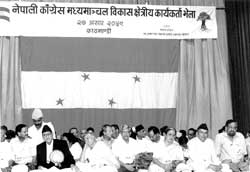 The flag of the Nepal Democratic Congress led by Subarna Sumshere Rana had four stars, and BP Koirala's Nepali National Congress flag had three stars and a rising sun. The flag's three colours symbolised the mountains, the hills and the plains. The rising sun symbolised the growing political awareness in Nepal. When the two parties decided to merge, it was decided that the flag of the Nepali National Congress would be adopted. But Subarna Sumshere had already made thousands of the flags with four stars, which he showed BP Koirala. BP asked Subarna Sumshere why he had ordered so many flags. He was told that they were needed to spread the word of revolution in Nepal. He also said that it would be expensive to produce another flag, and that those already ordered would be useless.
The flag of the Nepal Democratic Congress led by Subarna Sumshere Rana had four stars, and BP Koirala's Nepali National Congress flag had three stars and a rising sun. The flag's three colours symbolised the mountains, the hills and the plains. The rising sun symbolised the growing political awareness in Nepal. When the two parties decided to merge, it was decided that the flag of the Nepali National Congress would be adopted. But Subarna Sumshere had already made thousands of the flags with four stars, which he showed BP Koirala. BP asked Subarna Sumshere why he had ordered so many flags. He was told that they were needed to spread the word of revolution in Nepal. He also said that it would be expensive to produce another flag, and that those already ordered would be useless. All this happened before the parties formally merged in Chaitra 2006 BS [1951]. BP thought that the flag was just one symbol, and as Subarna Sumshere had already spent so much money on them, it would be wasteful to dump them. But he didn't say anything then. After both parties completed all the merger procedures, however, BP stood up and said that the flag of the new party would be that of the Nepal Democratic Congress. Ganesh Man Singh opposed the move strongly. BP said that money would be needed to re-print the Nepali National Congress flag and that the party did not have the resources.
That was how the flag with the four stars became the Congress emblem. The colour red symbolises revolution. It means that we will bring about change through revolution, and then revolt again if it is needed to safeguard democracy. The white in the flag stands for peace. The four stars represent the four basic freedoms.
After the revolution, it was decided to have elections in 2015 BS [1958]. The Congress picked the tree as its election symbol. There was no particular reason for this, though candidates tried to interpret the symbol differently. The Congress simply selected it from the options put forward by the Election Commission. Today the tree is synonymous with the Congress, and has deep meaning for long-time party cadres.
Today most Congress members say that they will side with the faction that gets to keep the election symbol and the party flag. This is what the two factions are now fighting for. The Koirala faction would never give up the two, and if the Deuba faction does not get them, its very existence would be threatened. It is difficult to establish a party based only on the fact of being in power, which makes the symbols valuable. The Election Commission should not have delayed its decision on the symbols because the longer it does, the more its commissioners credibility is strained. People sense it may be delaying making public its decision under pressure from the government.What about the side that does not get the Election Commission's approval to keep the symbols? Can it contest the elections? Would it? The main Congress would be that with the tree and flag, and this complicates the tussle. But the Commission has little room to make any decision other than the expected one.


